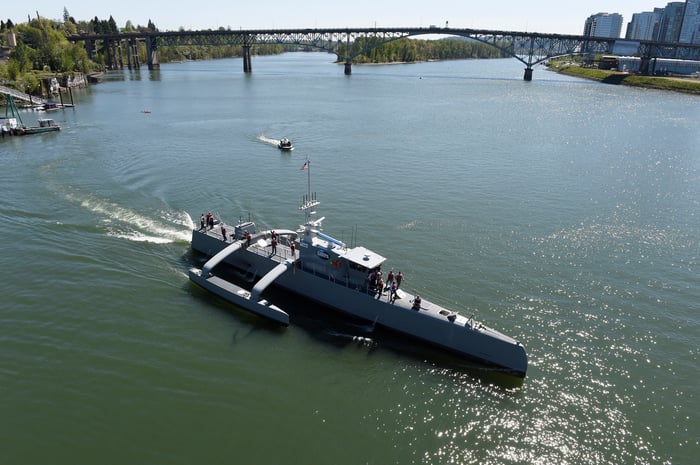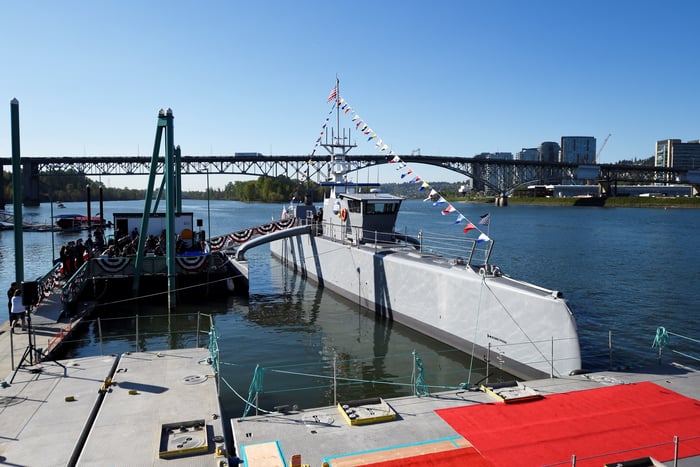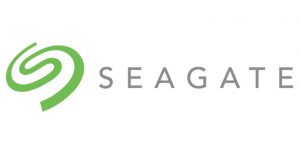The research arm of the U.S. Navy has successfully sailed an autonomous ship from San Diego to Hawaii and back with little human intervention. That's a huge accomplishment for the Navy, as well as for the contractor who supplied the brains for the vessel.
The Office of Naval Research said the Sea Hunter, a 132-foot-long trimaran designed by Leidos Holdings (NYSE:LDOS), completed the mission without a crew save for short boardings from an escort vessel to monitor electrical and propulsion systems. The voyage was part of a series of tests begun in 2016 and expected to extend through the rest of the year.

The Sea Hunter gets under way on the Willamette River in Portland, Ore. Image source: U.S. Navy photo by John F. Williams.
The ship is at the forefront of an effort by the Navy to rapidly expand its autonomous capabilities, with the service hoping to see the same sort of dramatic expansion of capabilities the Air Force experienced when it first introduced drones over the battlefield in the 1990s. The Sea Hunter is designed to stay at sea for months, hunting for mines, tracking submarines, keeping shipping lanes safe, and collecting intelligence.
The ship was built by privately held Vigor Industrial of Oregon, with Leidos providing the design and the technology to allow it to operate without anyone on board. The technology is based in part on work done for NASA's Jet Propulsion Laboratory for the Mars Exploration Rover.
A bigger Navy at a faction of the costWhile it is hard to imagine the Navy deploying crewless destroyers or larger vessels any time in the foreseeable future, the ability to deploy specialized autonomous craft has the potential to reduce the strain on the service and allow it to focus resources in other areas. The Sea Hunter was first envisioned as a submarine hunter, but as trials have progressed and the Navy has had more time with the ship, the potential use cases for the vessel have grown.
Eventually, the Navy hopes to use autonomous vessels in combat situations, providing sensor data and offensive firepower and to overwhelm and distract enemy radar and surveillance equipment to help shield crewed ships from danger.
While production costs are unclear, the Navy has previously said it believes it can procure autonomous ships fitting the Sea Hunter profile for as little as $20 million apiece and operate them for $15,000 to $20,000 per day. By comparison, a new Arleigh Burke-class destroyer costs $1.8 billion, and with its full crew costs $700,000 per day to operate.
The Pentagon has an ambitious timetable when it comes to uncrewed vessels. In 2016, Robert Work, at the time Deputy Secretary of Defense, said he hoped to see autonomous flotillas operating in the Pacific and Persian Gulf region within five years. Although that deadline will almost certainly be missed, this success of the latest test should provide momentum to the effort.
Disruption in the contractor base?The push toward autonomous ships will open new opportunities for non-traditional shipbuilders like Leidos and Textron, which has developed its own smaller robotic speedboat.
The impact on more traditional shipbuilders including Huntington Ingalls (NYSE:HII) and General Dynamics (NYSE:GE) is less clear. The Navy is seeking to expand its fleet by more than 25% to upwards of 355 ships, but a key unresolved issue with that plan is the ongoing expense of additional personnel needed to crew the new vessels. If autonomous ships can take over routine missions like data-gathering and patrolling shipping lanes, it could free up personnel and larger ships to take on new roles, and over time, it could reduce the need for that full expansion.

The Sea Hunter during its 2016 christening ceremony in Portland, Ore. Image source: Defense Advanced Research Projects Agency.
The contractors' flagship programs, including Huntington-made aircraft carriers and GD-made Columbia-class submarines, will proceed as scheduled. But longer-term autonomous technology could eat into future demand for destroyers, littoral combat ships, and a planned new frigate.
An optimist would hope that fewer destroyers and frigates would free up personnel and funding for more higher-margin carriers and subs, while a pessimist might fear that as autonomous tech advances, the emphasis on massive warships might decrease. In truth, this will take decades to play out, and while investors should monitor the situation, for now, there is ample funding for new Huntington and GD-built vessels.
It's all upside for LeidosLeidos is best known as providing outsourced IT, engineering, and science work to government customers, but it, like many of its peers, is attempting to diversify its revenue base by finding ways to apply its engineering skills to military hardware.
The Sea Hunter business is still just a drop in the bucket for Leidos, which has $10 billion in sales, but it is growing. The Navy, based on the initial trials, awarded Leidos up to $43.5 million to develop and build a sister ship, currently under construction in Mississippi, and the contractor was also awarded up to $36 million to explore development of torpedo countermeasure technologies for the ship.
The Navy has been tight-lipped about its long-term purchasing plans in its budget requests, but based on the public statements by Work and others, it's not unreasonable to expect the Pentagon to move aggressively to order perhaps hundreds of autonomous ships in the years to come. Thanks to the success of the Sea Hunter, it seems Leidos will have a role whether the Navy moves that design into production or if the company is brought on as a key contributor to another design.
It's too soon to buy or sell individual companies based on the impact of autonomous ships. But for holders of Leidos, already among the best buys among government services firms due to its scale, the Sea Hunter's success offers yet another potential avenue for the company to outperform.

 Source: Seagate
Source: Seagate